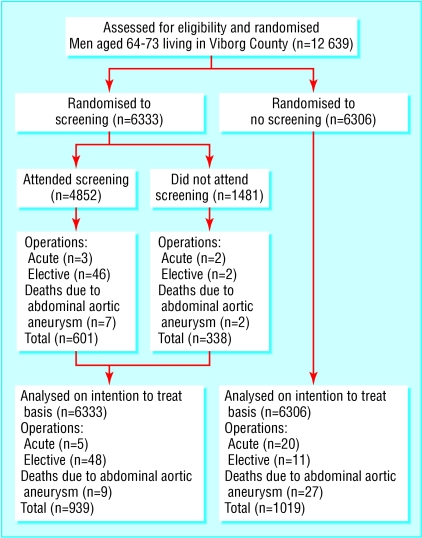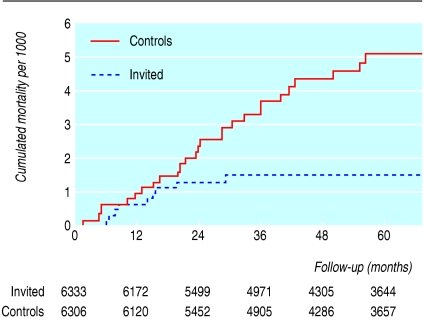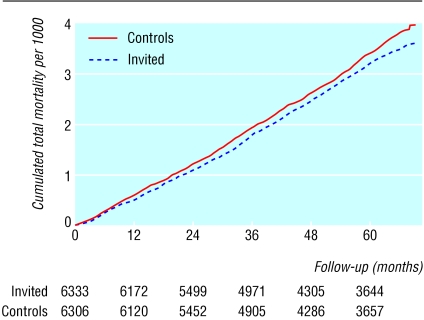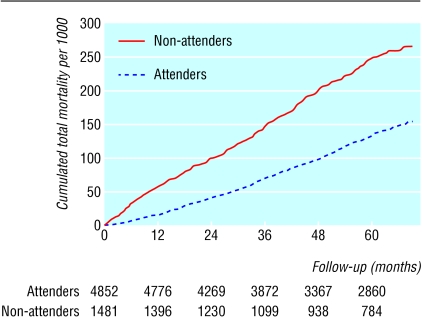Abstract
Objective To determine whether screening Danish men aged 65 or more for abdominal aortic aneurysms reduces mortality.
Design Single centre randomised controlled trial.
Setting All five hospitals in Viborg County, Denmark.
Participants All 12 639 men born during 1921-33 and living in Viborg County. In 1994 we included men born 1921-9 (64-73 years). We also included men who became 65 during 1995-8.
Interventions Men were randomised to the intervention group (screening by abdominal ultrasonography) or control group. Participants with an abdominal aortic aneurysm > 5 cm were referred for surgical evaluation, and those with smaller aneurysms were offered annual scans.
Outcome measures Specific mortality due to abdominal aortic aneurysm, overall mortality, and number of planned and emergency operations for abdominal aortic aneurysms.
Results 4860 of 6333 men were screened (attendance rate 76.6%). 191 (4.0% of those screened) had abdominal aortic aneurysms. The mean follow-up time was 52 months. The screened group underwent 75% (95% confidence interval 51% to 91%) fewer emergency operations than the control group. Deaths due to abdominal aortic aneurysms occurred in nine patients in the screened group and 27 in the control group. The number needed to screen to save one life was 352. Specific mortality was significantly reduced by 67% (29% to 84%). Mortality due to non-abdominal aortic aneurysms was non-significantly reduced by 8%. The benefits of screening may increase with time.
Conclusion Mass screening for abdominal aortic aneurysms in Danish men aged 65 or more reduces mortality.
Introduction
Ruptured abdominal aortic aneurysm occurs in about 1-3% of men aged 65 or more, 70-95% of whom die.1-4 Mortality in people undergoing elective surgery for abdominal aortic aneurysms is only 5-7%,1 but the condition seldom causes symptoms before rupture. Consequently, screening for such aneurysms is worth considering. A suitable and acceptable method of screening populations seems available.1,5-11 The psychological costs are limited12,13 because only 5% of people need rescanning every five years.14 The evidence base for treatment by size of aneurysm is clear.15,16 Abdominal aortic aneurysms may rupture during surveillance, however, and patients still die after surgery for a lesion that would never have ruptured if left untreated. Furthermore, surveillance decreases quality of life,12,17 more than 10% of patients have contraindications to surgery, and endovascular treatment does not remove the risk of rupture after initial treatment.18
These problems seem minor, however, if screening substantially reduces specific mortality. Consequently, we carried out a randomised controlled trial to determine whether screening Danish men aged 64-73 for abdominal aortic aneurysms reduces mortality.19
Materials and methods
In 1994 we randomised all men born during 1921-9 who lived in Viborg County, Denmark. To avoid delays between randomisation and screening, we randomised participants in blocks of about 1000. In 1995-8 we randomised all those who became 65. The mean age at randomisation was 67.7 years (range 64.3 to 73.8 years).
We randomly assigned the men to either screening (6333 participants) or the control group (6306). Participants in the screening group underwent abdominal ultrasonography at their regional hospital. Non-responders were reinvited once. Scanning (B mode) was carried out by a specially trained doctor and nurse using a Phillips SDR 1550 device with linear 4 MHz transducer and calliper light pen. Participants were not required to fast.
Baseline assessment and follow-up
We considered an abdominal aortic aneurysm to be present if the infrarenal aortic diameter was ≥ 3 cm. Participants with aneurysms ≥ 5 cm were referred to a vascular surgeon. The remaining participants with aneurysms were offered annual scans to check for expansion. They were referred for surgical evaluation if the aneurysm had expanded to ≥ 5 cm. After five years, men with an initial ectatic aorta (diameter 2.5-2.9 cm) were offered rescreening.14
Outcome measures
The primary outcome measures were specific mortality due to abdominal aortic aneurysm, total mortality, number of operations and indications for operations, and number of ruptured aneurysms. Data on operations were obtained from the patients' records.
We obtained data on deaths occurring from April 1994 to December 1999 through the Danish civil register and causes of death through the national register of causes of death. We obtained the hospital records and autopsy records of patients whose death certificates stated abdominal aortic aneurysm as the primary or contributing cause of death. The information was assessed by two vascular surgeons who were blinded to the randomisation group and to each other's evaluations. Each assessed the deaths to be certainly, possibly, or not caused by abdominal aortic aneurysm. We considered deaths to be due to abdominal aortic aneurysm when both assessors evaluated the death as certainly or possibly caused by such aneurysms.
Statistical analyses
We carried out analyses on an intention to screen basis from the date of randomisation. Fisher's exact test was used to compare proportions. We used Cox proportional hazards regression to compare specific mortality due to abdominal aortic aneurysm and overall mortality. As the proportional hazards assumption was not fulfilled, we decided to carry out separate analyses for the periods before and after 1.5 years after randomisation.
We calculated the expected number of life years gained within 5, 10, and 15 years for two hypothetical cohorts representing screened participants and controls, each of 6333 men aged 67. In the cohort representing the controls, we estimated the number of remaining life years from the life table for Danish men in 1995 and 1996. In the cohort representing the screened participants, we assumed the mortality for the period 1.5 to five years after randomisation to be reduced by the difference in specific mortality due to abdominal aortic aneurysm per 1000 years in the study (0.89, 95% confidence interval 0.40 to 1.37); before 1.5 years and after five years we assumed that the mortality was unaffected by screening. We selected this interval because evidence of a preventive effect was lacking until 1.5 years after randomisation. The observed age specific mortality among controls was close to Danish men in 1995 and 1996, but because we observed the controls for less than six years we could not use their data for projections beyond that. We carried out analyses using SPSS 10.0 and Stata 8.0.
Results
We randomised all 12 639 men aged 64-73 (mean age 67.7 years) living in Viborg County, Denmark (fig 1). They were followed up for a mean of 52 months (range < 0-69 months). The two groups were similar for duration of observation and age.
Fig 1.
Flow of participants through trial
Overall, 4860 of 6333 participants allocated to the intervention group were screened by abdominal ultrasonography (attendance rate 76.6%, 95% confidence interval 75.6% to 77.7%). The anterior to posterior diameter of the aorta was successfully measured in 4816 of the 4860 attenders (99.3%), and an abdominal aortic aneurysm was detected in 191 (4.0%, 3.4% to 4.6%). Twenty four men (0.5%, 0.3% to 0.7%) with an aneurysm ≥ 5 cm were referred for surgery. During the five years after screening, a further 22 men were referred for elective surgery due to expansion of an aneurysm.
Operations and ruptures
The screened group underwent significantly fewer emergency procedures than the control group (75.0%, 50.9% to 91.3%; table 1).
Table 1.
Relative risks associated with screening Danish men aged 64-73 for abdominal aortic aneurysms
| Variable | Screened group (n=6333) | Control group (n=6306) | Relative risk (95% CI) | P value |
|---|---|---|---|---|
| No of all operations | 53 | 31 | 1.70 (1.09 to 2.65) | 0.02 |
| No of elective operations | 48 | 11 | 4.35 (2.26 to 8.36) | <0.001 |
| No of emergency operations | 5 | 20 | 0.25 (0.09 to 0.66) | 0.002 |
| No of ruptured aneurysms | 8 | 29 | 0.27 (0.13 to 0.60) | 0.001 |
| No of deaths due to abdominal aortic aneurysm | 9 | 27 | 0.33 (0.16 to 0.71) | 0.003 |
| Total No (%) of deaths | 939 (14.8) | 1019 (16.2) | 0.92 (0.85 to 1.00) | 0.053 |
Overall, 59 participants were operated on electively: 48 in the screened group and 11 in the control group. Of these, three (two in the screened group) died within 30 days postoperatively (5.1%). A fourth died 2.5 months postoperatively due to complications. Of those referred for surgery after screening, two died before surgery—one due to ruptured abdominal aortic aneurysm (surgery had to be postponed because of acute myocardial infarction) and the other due to ruptured iliac aneurysms. Furthermore, three participants with abdominal aortic aneurysms in the screened group who were recommended for surgery died of ruptured aneurysm; one initially had contraindications for surgery, one refused surgery, and one did not attend for follow-up.
Sixteen of the 37 patients with recognised rupture underwent surgery (43.2%), 10 of whom died (62.5%). Overall, the case fatality due to ruptured abdominal aortic aneurysm was 81.1% (64.8% to 92.0%), and the incidence of recognised ruptured aneurysms in the control group was 1.07 per 1000 observation years.
Mortality and survival
Nine participants in the screened group died from abdominal aortic aneurysm compared with 27 in the control group (hazard ratio 0.33, 0.16 to 0.71; fig 2). During the 18 months after randomisation, the two groups showed similar mortality due to abdominal aortic aneurysm (0.77, 0.29 to 2.07), but thereafter mortality was lower in the screened group (0.11, 0.03 to 0.48).
Fig 2.
Kaplan-Meier estimates of mortality due to abdominal aortic aneurysm in Danish men aged 64-73 years. Difference between screened and control groups is P=0.003 (log rank test)
In the screened group, all cause mortality was insignificantly decreased (hazard ratio 0.92, 0.84 to 1.00; fig 3) and mortality from causes other than abdominal aortic aneurysm was also insignificantly decreased (0.92, 0.85 to 1.02).
Fig 3.
Kaplan-Meier estimates of total mortality in Danish men aged 64-73 years screened for abdominal aortic aneurysm and controls. Difference between screened and control groups is P=0.053 (log rank test)
The number of life years gained by offering 6333 men screening was 32 (14 to 49) during the first five years (table 2). If the prediction was extended to 10 and 15 years, the number of life years gained was 107 (48 to 164) and 158 (71 to 244), respectively.
Table 2.
Expected life years gained by inviting 6333 Danish men aged 64-73 to be screened for abdominal aortic aneurysm
| Period (years) after screening |
Expected life years remaining
|
Expected life years gained (95% CI) | |
|---|---|---|---|
| Screened group | Control group | ||
| 0-5 | 29 167 | 29 135 | 32 (14 to 49) |
| 0-10 | 52 275 | 52 168 | 107 (48 to 164) |
| 0-15 | 68 245 | 68 087 | 158 (71 to 244) |
Total mortality among non-attenders for screening was significantly higher than that among those who did attend for screening (hazard ratio 1.98, 1.73 to 2.26; fig 4).
Fig 4.
Kaplan-Meier estimates of total mortality among attenders and non-attenders for screening for abdominal aortic aneurysm. Difference is P<0.001 (log rank test)
Discussion
Screening Danish men aged 64-73 for abdominal aortic aneurysm reduced the need for emergency operations by 75% and reduced specific mortality due to such aneurysms by 67%. Thirty two life years were also gained during the five years after screening. Life years gained could be expected to increase to 107 and 158 after 10 and 15 years, respectively. The number needed to screen to save one life was 352—an acceptable number when compared with other types of screening.20
Potential bias
Our study groups had similar age distributions and average times at risk. Our analysis was carried out according to the intention to screen principle, and we have no reason to suspect confounding.
It is possible that some deaths may have been misclassified as due to abdominal aortic aneurysm, as autopsy was carried out in only 6% of the participants. However, 43% of the patients with ruptured aneurysm underwent surgery, providing enough data for evaluation. Furthermore, the two vascular surgeons disagreed on only three cases of death from hospital and autopsy reports. The assessors were blinded to group allocation, and therefore classification bias seems unlikely.
Deaths outside hospital may, however, have been misclassified; sudden death of a man with a known small abdominal aortic aneurysm might risk misclassification as due to the aneurysm. Cases with rupture of an unknown aneurysm risk being misclassified as cardiac disease because of the high prevalence of coexisting cardiac morbidity. Both types of misclassification would lead to an underestimation of the benefits of screening for abdominal aortic aneurysm. This could partly explain why total mortality in our study was close to being significantly reduced by screening (see fig 2).
Another explanation could be that discussions about risk factors during screening may have led to some participants changing their lifestyle. Smokers with abdominal aortic aneurysms were advised to stop smoking, and patients with sub-standard management of high blood pressure were advised to consult their doctor. No drugs or vitamin supplements were given. Another explanation could be that the screened group were favoured by randomisation by coincidence.
Nevertheless, the decrease in mortality due to such aneurysms seems to compare well with our earlier results on hospital deaths due to abdominal aortic aneurysms, when the diagnosis was certain.21
Interval screening
After 3-5 years, the 162 survivors with an aorta diameter initially sized at 25-29 mm were offered rescreening together with a random sample of 275 survivors with an aorta initially sized at less than 25 mm. More than 80% attended for rescreening. None of the controls had developed abdominal aortic aneurysms, whereas 28% of those with an initially sized aorta of 25-29 mm (range 30-48 mm) developed an aneurysm, with annual expansion rates varying from 1.0 to 4.7 mm.14 Three participants were later referred for surgical evaluation. Thus, rescreening patients with an aortic diameter of less than 25 mm seems unwarranted, whereas patients with preaneurysms of 25-29 mm diameter should be rescreened after five years.
The benefits
We observed no deaths due to abdominal aortic aneurysm in the screened group after 28 months (see fig 2). The number of elective procedures decreased rapidly after the first two years, and therefore attenders were at low risk of deaths due to such surgery. Four deaths due to abdominal aortic aneurysm occurred among non-attenders; the difference, however, was not significant and could be coincidental. Alternatively, selection could be an explanation. We know from our previous studies on this population, that those with diseases related to abdominal aortic aneurysms attend screening more often than those without,10,11 so the prevalence of such aneurysms among non-attenders could be expected to be lower than among attenders. However, the lower frequency of diseases related to abdominal aortic aneurysm among non-attenders was not associated with better survival (see fig 4).
Our main results are limited to a relatively short observation period. This is a conservative way to interpret the results, because benefits are expected to increase with time. We estimated the future benefits in terms of life years gained in 15 years. The main assumptions behind the estimates were conservative: that mortality not due to abdominal aortic aneurysm is unaffected by screening and that screening has a net effect on mortality due to abdominal aortic aneurysm only between 1.5 and five years after screening, with difference in mortality due to such aneurysms per 1000 years of 0.89 (0.40 to 1.37), as observed in the present study. After five years, mortality due to abdominal aortic aneurysm was assumed to be unaffected by screening.
This is probably an underestimation of the benefits, since the incidence of ruptured abdominal aortic aneurysms increases with age,1 although the frequency of non-compliance among patients with a conservatively treated aneurysm and those unfit for surgery will probably also increase with age.
In the UK multicentre aneurysm screening study,13,22 the relative risk reduction was 42% (95% confidence interval 22% to 58%). Although lower than in our study, this value is not significantly different from the 67% we observed.
In Western Australia,23 a randomised trial among men aged 65-83 showed an insignificant relative risk of death due to abdominal aortic aneurysm in the intervention group of 0.61 (95% confidence interval 0.33 to 1.11), but among the men aged 65-74 who were originally intended as participants the relative risk was significant (0.19, 0.04 to 0.89). The findings from that study are thus consistent with the UK multicentre study and our findings that screening reduces mortality due to abdominal aortic aneurysm. Further studies must analyse whether screening is cost effective in Denmark and Western Australia.
What is already known on this topic
Ultrasonography is a safe and reliable screening method for abdominal aortic aneurysms
The evidence base for treatment by size of aneurysm is clear
Randomised screening trials have shown a significant reduction in specific mortality due to abdominal aortic aneurysm
What this study adds
Mass screening for abdominal aortic aneurysm in Danish men aged 64-73 reduced specific mortality by 67%
The number needed to screen to save one life was 352
We thank vascular surgeons Jes Sandermann and Franz von Jessen for their independent review of classification of cause of death in the autopsy and hospital reports, and Anette Sahlholdt, Sten Vammen, Henriette Lindholt, and Jette Støvring for assistance with data collection.
Contributors: All authors planned the project, revised the article, and approved the final manuscript. JSL collected the data. JSL and SJ are guarantors. They accept full responsibility for the work and conduct of the study, had access to the data, carried out the analyses, and controlled the decision to publish.
Funding: Health department of Viborg County, Danish Heart Foundation, Danish National Council of Health Research, Foundation of Research in Western Denmark, and Foundation of Rosa and Asta Jensen.
Competing interests: None declared.
Ethical approval: The trial was approved by the local scientific ethics committee of the counties of Viborg and Nordjylland.
References
- 1.Lindholt JS. Considerations and experiences of screening for abdominal aortic aneurysms. PhD thesis. Copenhagen, Denmark: FADL's Forlag, 1998.
- 2.Lindholt JS, Henneberg EW, Fasting H. Decreased mortality of abdominal aortic aneurysms in a peripheral county. Eur J Vasc Endovasc Surg 1995;10: 466-9. [DOI] [PubMed] [Google Scholar]
- 3.Berridge DC, Chamberlain J, Guy AJ, Lambert D. Prospective audit of abdominal aortic aneurysm surgery in the northern region from 1988 to 1992. Northern Vascular Surgeons Group. Br J Surg 1995;82: 906-10. [DOI] [PubMed] [Google Scholar]
- 4.Bengtsson H, Bergqvist D. Ruptured abdominal aortic aneurysms: a population-based study. J Vasc Surg 1993;18: 74-80. [DOI] [PubMed] [Google Scholar]
- 5.Lindholt JS, Vammen S, Juul S, Henneberg EW, Fasting H. The validity of ultrasonographic scanning as screening method for abdominal aortic aneurysm. Eur J Vasc Endovasc Surg 1999;17: 472-5. [DOI] [PubMed] [Google Scholar]
- 6.Lucarotti M, Shaw E, Poskitt K, Heather B. The Gloucestershire aneurysm screening programme: the first 2 years' experience. Eur J Vasc Surg 1993;7: 397-401. [DOI] [PubMed] [Google Scholar]
- 7.Smith FC, Grimshaw GM, Paterson IS, Shearman CP, Hamer JD. Ultrasonographic screening for abdominal aortic aneurysm in an urban community. Br J Surg 1993;80: 1406-9. [DOI] [PubMed] [Google Scholar]
- 8.Scott RA, Wilson NM, Ashton HA, Kay DN. Influence of screening on the incidence of ruptured abdominal aortic aneurysm: 5-year results of a randomized controlled study. Br J Surg 1995;82: 1066-70. [DOI] [PubMed] [Google Scholar]
- 9.Morris GE, Hubbard CS, Quick CR. An abdominal aortic aneurysm screening programme for all males over the age of 50 years. Eur J Vasc Surg 1994;8: 156-60. [DOI] [PubMed] [Google Scholar]
- 10.Lindholt JS, Juul S, Henneberg EW, Fasting H. Is screening for abdominal aortic aneurysm acceptable to the population? Selection and recruitment to hospital-based mass screening for abdominal aortic aneurysm. J Public Health Med 1998;20: 211-7. [DOI] [PubMed] [Google Scholar]
- 11.Lindholt JS, Henneberg EW, Fasting H, Juul S. Mass or high-risk screening for abdominal aortic aneurysm. Br J Surg 1997;84: 40-2. [PubMed] [Google Scholar]
- 12.Lindholt JS, Vammen S, Fasting H, Henneberg EW. Psychological consequences of screening for abdominal aortic aneurysm and conservative treatment of small abdominal aortic aneurysms. Eur J Vasc Endovasc Surg 2000;20: 79-83. [DOI] [PubMed] [Google Scholar]
- 13.MASS trial participants. Multicentre aneurysm screening study (MASS): cost effectiveness analysis of screening for abdominal aortic aneurysm based on four year results from randomised controlled trial. BMJ 2002;325: 1135-41. [DOI] [PMC free article] [PubMed] [Google Scholar]
- 14.Lindholt JS, Vammen S, Juul S, Fasting H, Henneberg EW. Optimal interval screening and surveillance of abdominal aortic aneurysms. Eur J Vasc Endovasc Surg 2000;20: 369-73. [DOI] [PubMed] [Google Scholar]
- 15.UK Small Aneurysm Trial Participants. Mortality results for randomised controlled trial of early elective surgery or ultrasonographic surveillance for small abdominal aortic aneurysms. Lancet 1998;352: 1649-55. [PubMed] [Google Scholar]
- 16.Lederle FA, Wilson SE, Johnson GR, Reinke DB, Littooy FN, Acher CW, et al. Immediate repair compared with surveillance of small abdominal aortic aneurysms. N Engl J Med 2002;346: 1437-44. [DOI] [PubMed] [Google Scholar]
- 17.UK Small Aneurysm Trial Participants. Health service costs and quality of life for early elective surgery or ultrasonographic surveillance for small abdominal aortic aneurysms. UK Small Aneurysm Trial Participants. Lancet 1998;352: 1656-60. [PubMed] [Google Scholar]
- 18.Harris PL, Vallabhaneni SR, Desgranges P, Becquemin JP, van Marrewijk C, Laheij RJ. Incidence and risk factors of late rupture, conversion, and death after endovascular repair of infrarenal aortic aneurysms: the EUROSTAR experience. European Collaborators on Stent/graft techniques for aortic aneurysm repair. J Vasc Surg 2000;32: 739-49. [DOI] [PubMed] [Google Scholar]
- 19.Lindholt JS, Henneberg EW, Fasting H, Juul S. Hospital based screening of 65-73 year old men for abdominal aortic aneurysms in the county of Viborg, Denmark. J Med Screen 1996;3: 43-6. [DOI] [PubMed] [Google Scholar]
- 20.Rembold CM. Number needed to screen: development of a statistic for disease screening. BMJ 1998;317: 307-12. [DOI] [PMC free article] [PubMed] [Google Scholar]
- 21.Lindholt JS, Juul S, Fasting H, Henneberg EW. Hospital costs and benefits of screening for abdominal aortic aneurysms. Results from a randomised population screening trial. Eur J Vasc Endovasc Surg 2002;23: 55-60. [DOI] [PubMed] [Google Scholar]
- 22.Ashton HA, Buxton MJ, Day NE, Kim LG, Marteau TM, Scott RA, et al. The multicentre aneurysm screening study (MASS) into the effect of abdominal aortic aneurysm screening on mortality in men: a randomised controlled trial. Lancet 2002;360: 1531-9. [DOI] [PubMed] [Google Scholar]
- 23.Norman PE, Jamrozik K, Lawrence-Brown MM, Le MTQ, Spencer CA, Tuohy RJ, et al. Population based randomised controlled trial on impact of screening on mortality from abdominal aortic aneurysm. BMJ 2004;329: 1259-62. [DOI] [PMC free article] [PubMed] [Google Scholar]






